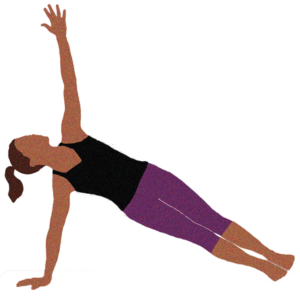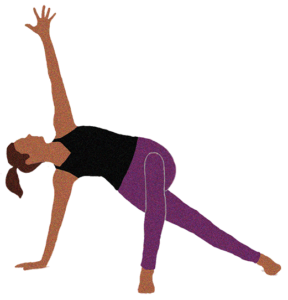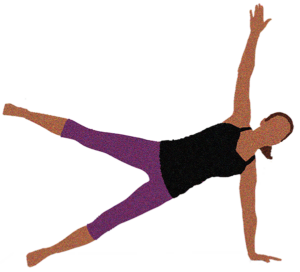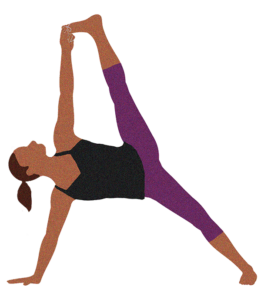 Vasisthasana, or the side plank, is an excellent strength-building yoga pose with a number of variations for every skill level in yoga practice. The side plank offers many benefits, including strengthening the muscles in the shoulders, hips, and core and improving balance. Of particular note, the side plank strengthens the body’s deepest abdominal muscle—the quadratus lumborum—which is located in the lower back on either side of the lumbar spine. This muscle provides support to the other core muscles in the body when breathing and helps stabilize the lumbar area of the spine. When the surrounding core muscles are weak, the quadratus lumborum muscle is forced to work harder to support the body, resulting in muscle tenseness and lower back pain. This, in turn, can result in a change in gait or posture to compensate for the pain, which then places stress on other parts of the body, such as the hips, resulting in additional injury and pain. Here, we present the basic side plank pose along with some of its variations, all of which can strengthen shoulder, hip, and core muscles, improve balance, and help prevent back injury.1
Vasisthasana, or the side plank, is an excellent strength-building yoga pose with a number of variations for every skill level in yoga practice. The side plank offers many benefits, including strengthening the muscles in the shoulders, hips, and core and improving balance. Of particular note, the side plank strengthens the body’s deepest abdominal muscle—the quadratus lumborum—which is located in the lower back on either side of the lumbar spine. This muscle provides support to the other core muscles in the body when breathing and helps stabilize the lumbar area of the spine. When the surrounding core muscles are weak, the quadratus lumborum muscle is forced to work harder to support the body, resulting in muscle tenseness and lower back pain. This, in turn, can result in a change in gait or posture to compensate for the pain, which then places stress on other parts of the body, such as the hips, resulting in additional injury and pain. Here, we present the basic side plank pose along with some of its variations, all of which can strengthen shoulder, hip, and core muscles, improve balance, and help prevent back injury.1
 Basic Side Plank (Vasisthasana)2
Basic Side Plank (Vasisthasana)2
This is the most basic side plank pose and will serve as the foundation for the pose’s many variations.
1. Lie, stomach down, on the floor. Place hands, palms down, directly adjacent to the shoulders, and push up until arms are completely straight, with feet together, toes and balls of the feet on the ground, and heels pointing straight up. Look down at the floor and focus on keeping the back and legs straight and core muscles engaged (this is the plank pose).
2. Transfer your weight to your right hand and raise your left hand off the floor and up toward the ceiling. Roll from the ball of your right foot onto its outer edge.
3. Place your left foot directly on top of your right foot. Keep your legs straight and flex both feet.
4. Your left hip should be stacked directly over your right hop. To prevent the hips from sagging down, focus on lifting them upward.
5. Gaze up at your left fingertips and hold this pose for several breaths.
6. Come back into plank position and repeat the movements on the other side.
 Supported Side Plank3
Supported Side Plank3
For those who aren’t able to keep their hips from sagging downward, this variation of side plank provides more support to the lower body.
1. Position yourself on hands and knees, arms straight, palms down, hands aligned with shoulders, legs bent at the knees and aligned with hips. With the toes and balls of your feet on the ground and heels pointing up, slowly straighten legs at the knees, and lift your body up, bottom first, so that your body forms a triangle, with your bottom being the center top, pushing your weight into your splayed hands without changing their position (this is the downward facing dog pose).
2. From downward facing dog, bend at the left knee and bring the left foot under and slightly in front of the body, with toes facing out, away from right leg, so that your left foot more or less aligned with your right knee.
3. With right leg still straight, roll the right foot from the ball onto it’s whole outer edge, rotating your left hip up, right hip down.
4. Slowly raise the left arm up toward the ceiling, flexing your right foot, and pressing into both feet to lift your hips.
5. Gaze up at your left hand and hold this position for several breaths. Slowly step back into the downward facing dog pose and repeat the sequence on the other side.
 Forearm Side Plank3
Forearm Side Plank3
For people who are unable to put a lot of weight on one or both of their wrists, this variation of the side plank takes the pressure away from the wrists.
1. Begin in downward facing dog position (see Supported Side Plank instructions).
2. Lower both forearms to the floor, spreading out your fingers and pressing them down (this is the dolphin pose).
3. Shift forward to a plank with the forearms still on the floor. Keep your back and legs straight and core muscles are engaged. Do not let your hips droop down to the floor.
4. Pivot on your right elbow, so that your right forearm is pointing out away from your body, keeping right elbow under right shoulder. At the same time, shift from the ball of your right foot to its outside edge.
5. Lift your left arm and gaze upwards, pressing into your forearm to keep your right shoulder from collapsing.
6. Stack your left foot on top of your right foot, keeping legs and back straight and core muscles engaged. Hold this position for several breaths.
7. Come back into downward facing dog position and repeat on the other side.
These next few poses are for those who are looking for something a bit more challenging than the basic side plank.
 Side Plank with Tree Legs2
Side Plank with Tree Legs2
1. Start in the basic side plank pose, left hand and left leg down.
2. Bend right leg and slide the right foot along the inside of the left leg. Try to get it to your left inner thigh, but if it doesn’t come up that far, place it on the inside of your left calf. Don’t put it directly on the side of your knee. Keep body and left leg straight and keep hips lifted so they don’t droop to the floor.
3. Lift right arm up to the ceiling and gaze upward. Hold this pose for several breaths, and then repeat on the other side.
 Plank With One Leg Lifted2
Plank With One Leg Lifted2
1. Start in the basic side plank pose, left hand and left leg down.
2. Lift your right arm up, with fingers pointing upwards. Gaze up at your fingers.
3. Lift your right leg as much as you can off your left leg (from a few inches to several feet). Keep both legs straight.
4. Hold pose for several breaths, release, and repeat on the other side. If you start to lose your balance, it is ok to look down at your lower hand.
 Full Side Plank (Full Vasisthasana)2
Full Side Plank (Full Vasisthasana)2
If you can lift your upper leg high enough, you may be ready for the full Vasisthasana.
1. Start in the basic side plank pose, left hand and left leg down.
2. Bend the knee of your upper leg and take hold of your big toe with your upper hand.
3. Straighten your lifted arm and leg as much as possible, aiming the sole of your foot toward the ceiling.
4. Gaze up and hips lifted. Hold pose for several breaths.
5. Let go of your toe, lower your leg, and do the pose on the other side.
SOURCES
1. Yetman D. The benefits of a side plank and how to do it safely. 10 Nov 2020. https://www.healthline.com/health/side-plank. Accessed 2 Nov 2021.
2. Yoga Journal site. Side plank pose. https://www.yogajournal.com/poses/types/balancing/side-plank-pose/. Accessed 2 Nov 2021.
3. Pizer A. Vasisthasana side plank pose and variations. Last reviewed 31 Jul 2020. https://www.verywellfit.com/side-plank-vasisthasana-variations-3567151. Accessed 2 Nov 2021.


 Basic Side Plank (Vasisthasana)2
Basic Side Plank (Vasisthasana)2 Supported Side Plank3
Supported Side Plank3 Forearm Side Plank3
Forearm Side Plank3 Side Plank with Tree Legs2
Side Plank with Tree Legs2 Plank With One Leg Lifted2
Plank With One Leg Lifted2 Full Side Plank (Full Vasisthasana)2
Full Side Plank (Full Vasisthasana)2

